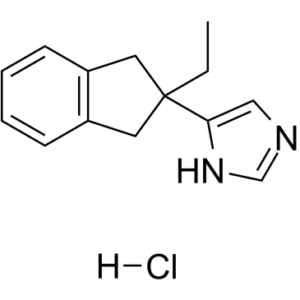Atipamezole HCl (MPV-1248)
This product is for research use only, not for human use. We do not sell to patients.

For small sizes, please check our retail website as below: www.invivochem.com
| Size | Price | Stock |
|---|---|---|
| 250mg | $759 | Check With Us |
| 500mg | $1150 | Check With Us |
| 1g | $1725 | Check With Us |
Cat #: V2589 CAS #: 104075-48-1 Purity ≥ 98%
Description: Atipamezole (Antisedan, MPV-1248) is a synthetic α2 adrenergic receptor antagonist with a Ki of 1.6 nM.
Top Publications Citing Invivochem Products
Publications Citing InvivoChem Products
Product Promise

- Physicochemical and Storage Information
- Protocol
- Related Biological Data
- Stock Solution Preparation
- Quality Control Documentation
| Molecular Weight (MW) | 248.75 |
|---|---|
| Molecular Formula | C14H16N2.HCl |
| CAS No. | 104075-48-1 |
| Storage | -20℃ for 3 years in powder formr |
| -80℃ for 2 years in solvent | |
| Solubility In Vitro | DMSO: 12 mg/mL (48.24mM)r |
| Water: 21 mg/mL (84.4 mM)r | |
| Ethanol: 49 mg/mL (197 mM) | |
| Synonyms | Antisedan, MPV-1248 hydrochloride, MPV1248 hydrochloride, MPV 1248 hydrochloride |
| Protocol | In Vitro | The affinity of atipamezole for α2-adrenoceptors and its α2/α1 selectivity ratio are considerably higher than yohimbine. Atipamezole is not selective for subtypes of α2-adrenoceptors. It has negligible affinity for 5-HT1, 5-HT2 and I2 bindings sites |
|---|---|---|
| In Vivo | Atipamezole is well tolerated in rodents. In anesthetized, normotensive rats, the cardiovascular effects of atipamezole (0.01–1 mg/kg, i.v.) are rather modest. Atipamezole is commonly used by veterinarians to awaken animals from sedation or anesthesia. Atipamezole increases sexual activity in rats and monkeys. In animals with sustained nociception, atipamezole increases pain-related responses by blocking the noradrenergic feedback inhibition of pain. Atipamezole at low doses has beneficial effects on alertness, selective attention, planning, learning, and recall in experimental animals, but not necessarily on short-term working memory |
These protocols are for reference only. InvivoChem does not
independently validate these methods.
| Solvent volume to be added | Mass (the weight of a compound) | |||
|---|---|---|---|---|
| Mother liquor concentration | 1mg | 5mg | 10mg | 20mg |
| 1mM | 4.0201 mL | 20.1005 mL | 40.2010 mL | 80.4020 mL |
| 5mM | 0.8040 mL | 4.0201 mL | 8.0402 mL | 16.0804 mL |
| 10mM | 0.4020 mL | 2.0101 mL | 4.0201 mL | 8.0402 mL |
| 20mM | 0.2010 mL | 1.0050 mL | 2.0101 mL | 4.0201 mL |
The molarity calculator equation
Mass(g) = Concentration(mol/L) × Volume(L) × Molecular Weight(g/mol)
Mass
=
Concentration
×
Volume
×
Molecular Weight*
The dilution calculator equation
Concentration(start)
×
Volume(start)
=
Concentration(final)
×
Volume(final)
This equation is commonly abbreviated as: C1 V1 = C2 V2
Concentration(start)
C1
×
Volume(start)
V1
=
Concentration(final)
C2
×
Volume(final)
V2
Step One: Enter information below
Dosage mg/kg
Average weight of animals g
Dosing volume per animal µL
Number of animals
Step Two: Enter the in vivo formulation
%DMSO
+
%
+
%Tween 80
+
%ddH2O
Calculation Results:
Working concentration:
mg/ml;
Method for preparing DMSO master liquid:
mg
drug pre-dissolved in
µL
DMSO(Master liquid concentration
mg/mL)
,Please contact us first if the concentration exceeds the DMSO solubility of the batch of drug.
Method for preparing in vivo formulation:
Take
µL
DMSO master liquid, next add
µL
PEG300, mix and clarify, next add
µL
Tween 80,mix and clarify, next add
µL
ddH2O,mix and clarify.
Note:
- (1) Please be sure that the solution is clear before the addition of next solvent. Dissolution methods like vortex, ultrasound or warming and heat may be used to aid dissolving.
- (2) Be sure to add the solvent(s) in order.




































